The Indigenous Ixil People
Ethnonyms: Ichil Countries inhabited: USA, Guatemala Language family: Mayan Language branch: Mamean
Click/tap an image to begin a captioned slideshow and, where available, stock licensing information.

 Caught somewhere between modernity and tradition, the 90,000 indigenous Ixil Maya people living in the world today
call the high Cuchumatanes mountains and cloud forests of northeast Guatemala their home. The region
is almost constantly misty
which reminds the visitor of the isolation in which the Ixil have lived since a thousand years
"before Columbus."
Caught somewhere between modernity and tradition, the 90,000 indigenous Ixil Maya people living in the world today
call the high Cuchumatanes mountains and cloud forests of northeast Guatemala their home. The region
is almost constantly misty
which reminds the visitor of the isolation in which the Ixil have lived since a thousand years
"before Columbus."
Today they live mainly in three small communities that form the so-called Ixil Triangle:
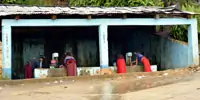
 Santa Maria Nebaj, San Juan Cotzal and
San Gaspar Chajul. There are also many small Ixil villages dotted around the area and some of these
have only a handful of families.
Santa Maria Nebaj, San Juan Cotzal and
San Gaspar Chajul. There are also many small Ixil villages dotted around the area and some of these
have only a handful of families.
Life in these Ixil communities can be harsh and about as basic as life can be in the modern world.
Agriculture is still the main livelihood and the standard of living is low even by Guatemalan standards.
Walking around these communities the visitor sees many signs of this. Women doing laundry in a
stream is by no means an unusual sight in Maya communities.
 But for even a small town with electricity
it is unusual that a modern "laundromat" (the one pictured above, right was built in 2013) is
nothing more than pumped stream water inside an open, concrete shelter.
But for even a small town with electricity
it is unusual that a modern "laundromat" (the one pictured above, right was built in 2013) is
nothing more than pumped stream water inside an open, concrete shelter.
It is not only isolation that has kept Ixil culture intact to a relatively large extent.
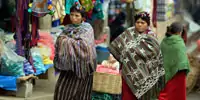 Most Ixil people still speak the Ixil language as their first language and many still do not speak Spanish centuries
after the Spanish first arrived in the area. The Ixil have also resisted outside influence even in modern
times.
Most Ixil people still speak the Ixil language as their first language and many still do not speak Spanish centuries
after the Spanish first arrived in the area. The Ixil have also resisted outside influence even in modern
times.
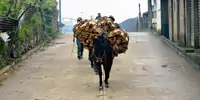 In each community signs are posted either in Ixil only or bilingually with Ixil before Spanish.
Traditional dress is still worn (although these days mostly by women only).
In each community signs are posted either in Ixil only or bilingually with Ixil before Spanish.
Traditional dress is still worn (although these days mostly by women only).
Due to the climate there is an almost constant need for fuel to heat homes.
 Firewood can always be seen being gathered from the surrounding forests and transported back to people's houses. A wealthier
family may own a donkey to make the task more efficient but in most cases people
Firewood can always be seen being gathered from the surrounding forests and transported back to people's houses. A wealthier
family may own a donkey to make the task more efficient but in most cases people
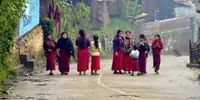 (of all ages) act as their own pack animals.
(of all ages) act as their own pack animals.
It is more common for families to own livestock. In fact scenes such as the one pictured on the right are
so common in these communities that the visitor might be led into thinking that livestock are part of the family.
 Venturing into the countryside the visitor sees all manner of livestock being shepherded.
Venturing into the countryside the visitor sees all manner of livestock being shepherded.
 It is easy to get the impression from these photos that Ixil communities are closely-knit ones.
And that impression is certainly accurate. Probably the best place to observe it is in the center of
any of the three main villages in the marketplace.
All kinds of things are sold here — once again by people of all ages.
The most common items are food and basic household goods but particularly
striking are hand-woven fabrics
It is easy to get the impression from these photos that Ixil communities are closely-knit ones.
And that impression is certainly accurate. Probably the best place to observe it is in the center of
any of the three main villages in the marketplace.
All kinds of things are sold here — once again by people of all ages.
The most common items are food and basic household goods but particularly
striking are hand-woven fabrics
 and the clothes that are made from them — also by hand. In San Gaspar Chajul
I was walking around the marketplace when I
and the clothes that are made from them — also by hand. In San Gaspar Chajul
I was walking around the marketplace when I
 came across this woman and her daughter selling both fabric and clothes.
came across this woman and her daughter selling both fabric and clothes.
In the late-19th Century, political changes in Guatemala forced the Ixil to give up half of their traditional land. Still, they tenaciously held onto their traditions and their knowledge of how to live and survive in an inhospitable, unforgiving environment.
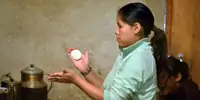 More recently, in the 1980s, the Guatemalan Civil War
had a devastating impact on the Ixil population and their psyche. The military government targeted
both its indigenous and non-indigenous people during the war, but the Ixil were especially targeted:
they were killed by the thousands and many remain unaccounted for. The Ixil are only now beginning
to recover and in the way they have only ever known how to.
More recently, in the 1980s, the Guatemalan Civil War
had a devastating impact on the Ixil population and their psyche. The military government targeted
both its indigenous and non-indigenous people during the war, but the Ixil were especially targeted:
they were killed by the thousands and many remain unaccounted for. The Ixil are only now beginning
to recover and in the way they have only ever known how to.
Photography copyright © 1999 -
2025,
Ray Waddington. All rights reserved.
Text copyright © 1999 -
2025,
The Peoples of the World Foundation. All rights reserved.

Waddington, R., (2014) The Indigenous Ixil People. The Peoples of the World Foundation. Retrieved December 18, 2025, from The Peoples of the World Foundation. <https://www.peoplesoftheworld.org/text?people=Ixil>
Web Links
Indigenous Ixil Maya Migration (short film on YouTube)
Trekking in the Cuchumatanes Mountains, Guatemala (Part 1)
Trekking in the Cuchumatanes Mountains, Guatemala (Part 2)
Knowledge From the Perspective of the Mayan Ixil People
Limitless Horizons Ixil
Books
Badgley Place, S., (2013) Guatemala Journey Among the Ixil Maya. Susanna Badgley Place.
Colby, B. N. and Van den Berghe, P. L., (1969) Ixil Country: A Plural Society in Highland Guatemala. Berkeley: University of California Press.
Stoll, D., (1993) Between Two Armies in the Ixil Towns of Guatemala. New York: Columbia University Press.


